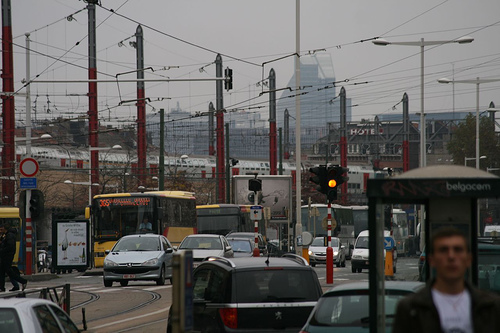Brussels receives a car-free makeover
Brussels, one of Europe’s most traffic-jammed cities, may soon go car-free — at least in part. The city’s newly inaugurated mayor, Yvan Mayeur of the Socialist party, hopes to transform the central area of Belgium’s capital into a pedestrian-only area, according to a recent report by The Atlantic.

Go ahead, you try making your way through this mess. From chantrybee.
Brussels is notorious for its congestion. TomTom, the satellite navigation company, ranked Brussels’ congestion level at 34 percent, its delay per hour driven in peak periods at 50 minutes, and its delay per year with a 30-minute commute at 104 hours. (Rome, Italy clocked in with a 42-minute delay per hour; Marseille, France had a 47-minute delay per hour; and London boasted a total 27 percent congestion level.)
Another study placed Brussels at the very top of the continent’s Worst Urban Congestion list: As Forbes reports, traffic and navigation service provider INRIX ranked Brussels as the world’s worst locale for traffic jams, with the second-worst city for traffic jams as Antwerp, also in Belgium. On the whole, traffic in Europe dropped over the course of the year studied – largely due to the economy’s slowdown.
The remaining cities on the INRIX study’s worst city list included: Los Angeles, Milan, London, Paris, Honolulu, Rotterdam (Netherlands), Manchester (UK), and San Francisco.
But back to Brussels: If the pedestrianization of central Brussels is approved, the area’s four-lane boulevard and select plazas would be transformed into a long promenade, linking with another, existing pedestrian zone and merging “the narrow streets around the city’s Grand Place and Rue Neuve, turning Brussels’ core into a spacious, rambling open-air living room,” according to The Atlantic.
While Brussels may sound cosmopolitan to those who have never visited, among Europeans, it has a bad rep as a dirty, dull city with an ugly urbanization process of its own to match: Brusselization. The term refers to an urban planning focus on 1) cars as preferred transportation and 2) the modern and slapdash high-rises that first sprung up, replacing historic buildings, during the city’s uncontrolled development from the late 1950s to the 1970s. During Brusselization, certain of Brussels’ central roads were transformed into a “mini highway,” increasing traffic and congestion that continues today.

Longtime visitors observe that the sudden proliferation of EU buildings made an already crowded, overbuilt city even more crowded. From Karen Rustad.
There are increasingly more vehicles per person in the Low Countries, which likely contributes to traffic. In Belgium, according to the World Bank, there were 552 vehicles per 1,000 people in 2009 and 559 per 1,000 people in 2010. The Netherlands also saw a slight rise, from 523 per 1,000 in 2009 to 527 per 1,000 in 2010. Luxembourg held steady at 729 vehicles per 1,000 in 2009 and 2010 – one of the top ratios of cars-to-people in the world.
(Interestingly, traffic increased in Luxembourg while it decreased throughout the majority of Europe, according to the INRIX study. Luxembourg is home to the world’s highest GDP per capita and highest per capita income, which suggests vehicle availability.) For comparison: In 2010, the U.S.’s rate was 797 vehicles per 1,000 people; Bangladesh’s rate was 3 ; Israel’s was 322; and France’s was 580.
So far, Brussels’s pedestrian-friendly proposal has found some support with residents. Le Soir, a Belgian newspaper, reported that 61 percent support the proposed changes. No word on whether the surveyed were bikers, pedestrians, or drivers.
Category: Automotive, Pedestrian safety, Trends


















